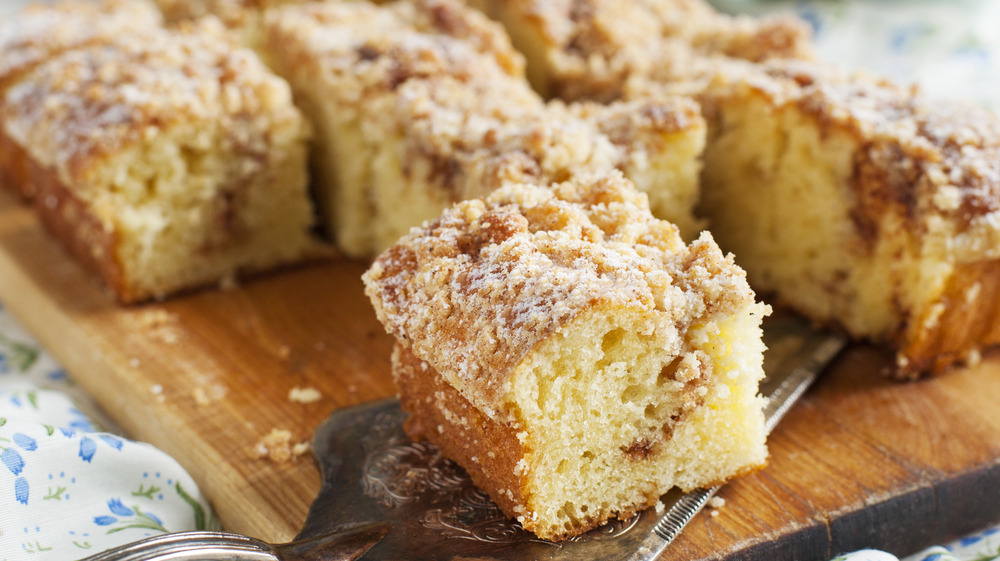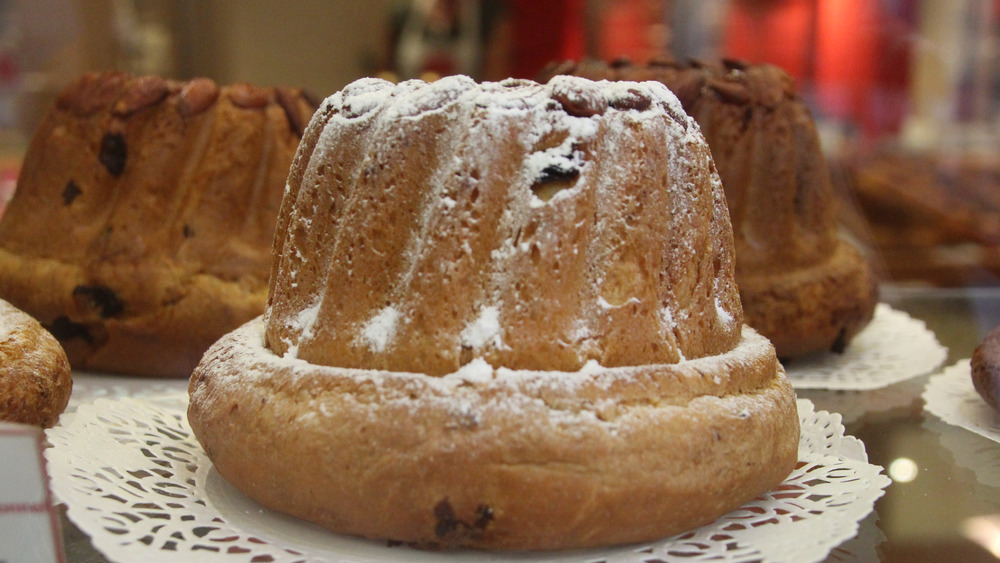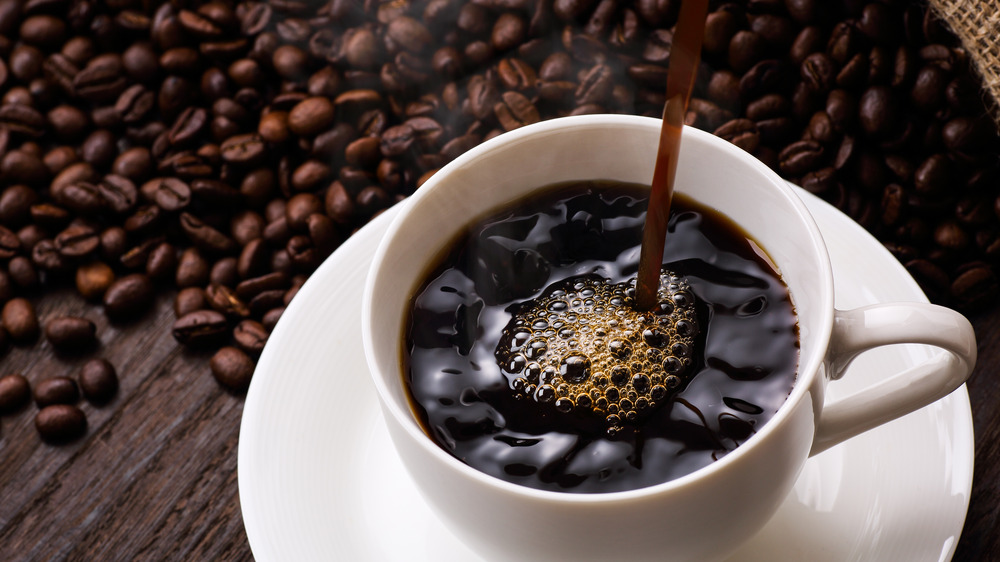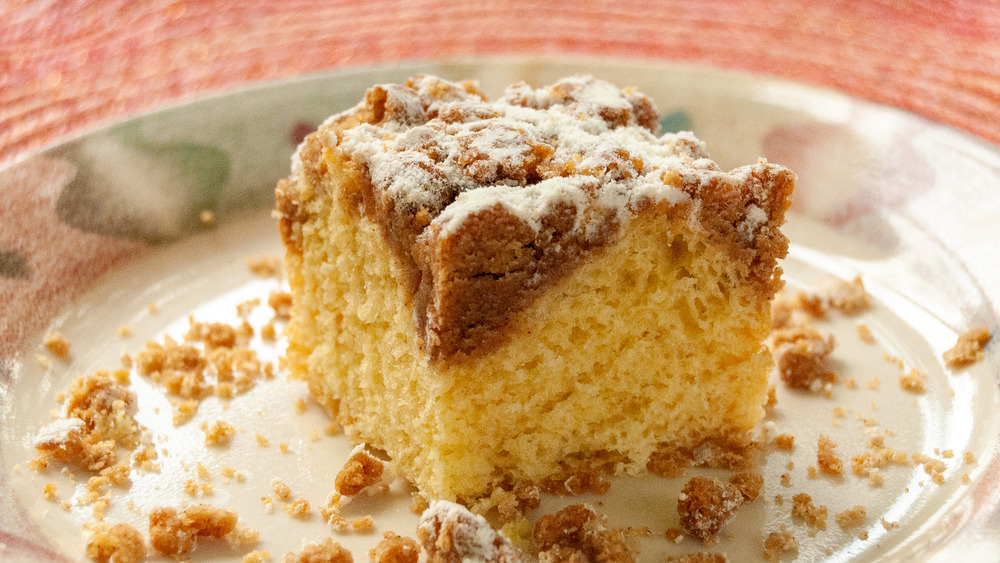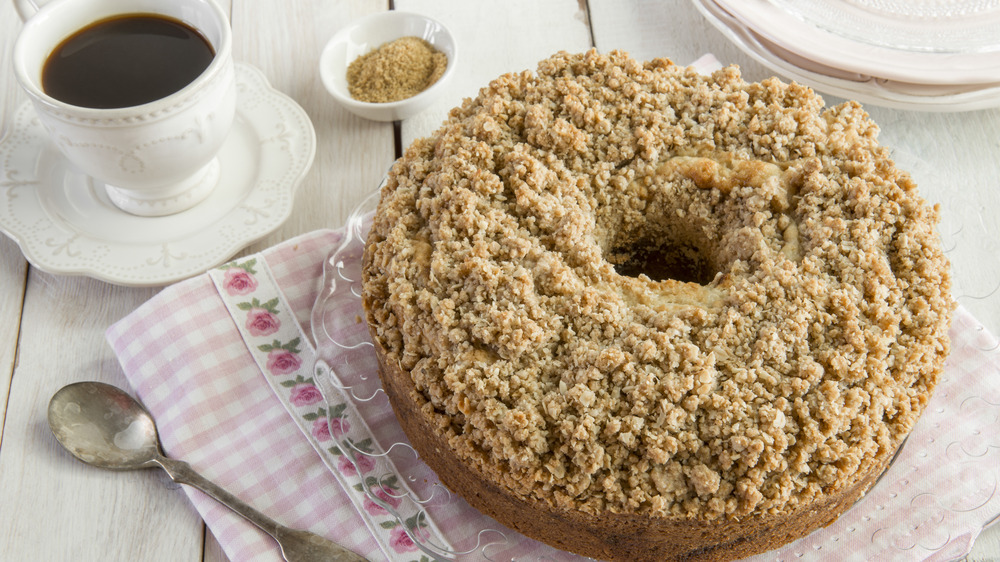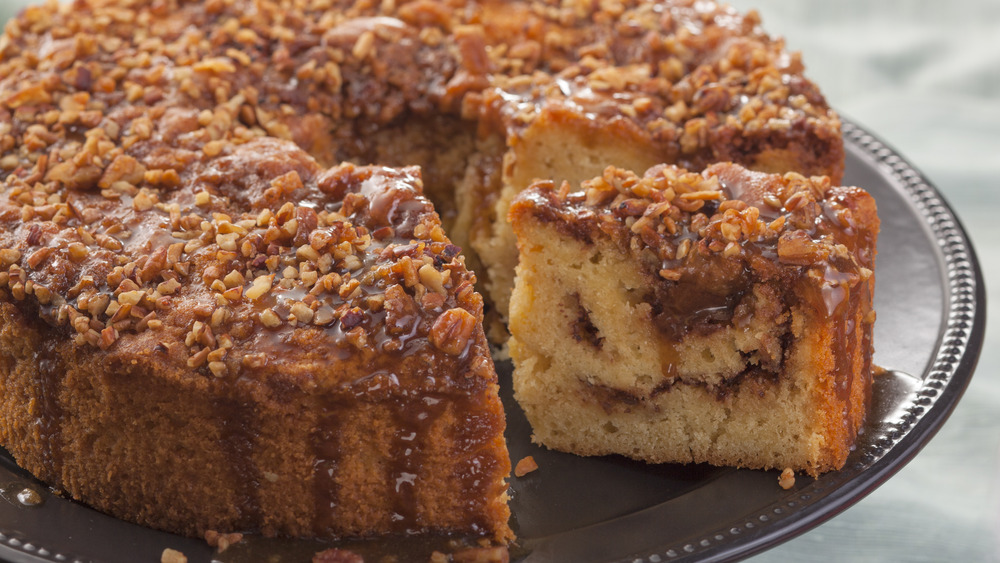The Untold Truth Of Coffee Cake
Coffee cakes are homey, tasty, and ubiquitous. You can find them everywhere from mom's kitchen to upscale bakeries, as well as prepackaged in grocery stores, or sliced up at bake sales and potlucks. So what's the story behind this sweet cake?
In simple terms, Baking Bites describes coffee cake as a soft, sweet cake that's topped with a crumbly blend called streusel — the streusel might also be layered through the center of the cake. As a definition, according to Baker Bettie, streusel is made by cutting cold butter into a mixture of dry ingredients such as flour, sugar, and spices like cinnamon.
Beyond that, Baking Bites shares that coffee cakes might also have glaze spooned over the top, and mix-ins can include chopped nuts, fresh fruit, or chunks of chocolate, caramel, and other flavorings. This means that every coffee cake can be as unique as the person making it.
Given its many varieties, this beloved centuries-old baked good deserves a spotlight for how it perfectly encapsulates baking ingenuity and exemplifies our love of sweet noshes paired with a hot cup of coffee.
Coffee cake wasn't invented—it evolved
We don't have just one person to thank for coffee cakes, we have generations. According to Food Timeline, these treats evolved from other pastries over several centuries. Sweetened breads raised with yeast, in fact, are documented back to the 1600s when they were popular in many European countries, including Germany, Switzerland, Denmark, Sweden, and Norway.
Around the same time, the National Coffee Association says that coffee had been introduced to Europe in the previous century. It caught on quickly, and by the 1600s there were also hundreds of coffee houses across the continent. Food Timeline further notes that traditional sweet breads, along with stimulating conversation, became a natural pairing with coffee — similar to how it remains today.
By the mid-19th century, immigrants from these coffee- and sweet bread–loving countries arrived in America with their traditional recipes in hand (via Tori Avey). Though the treats they brought with them began as yeast-risen cookies, scones, and other sweetened breads, the delectables eventually became more cake-like with a tender crumb. Smithsonian Magazine notes that both baking powder and baking soda were introduced at this time (in 1856), which helped home cooks create the early version of coffee cakes that resemble what we know today.
Coffee cake isn't (always) made with coffee
Its name might lead you to believe that coffee cake is made with, or at least tastes like, coffee. (And that if you don't like coffee, you should steer clear of this cake.) However, Baking Bites points out that the name "coffee cake" simply comes from the fact that these cakes are often enjoyed alongside a cup of coffee—much like the term "tea cakes" refers to having pastries served with tea, rather than being made with tea.
That didn't stop some bakers though from taking a literal approach, at one time incorporating brewed coffee into these popular cakes. Tori Avey shares that several late 19th century coffee cake recipes, including some in the original Fannie Farmer Cookbook, are rich butter cake foundations with a generous splash of coffee mixed inside the batter.
However, a quick survey of current, basic coffee cake recipes — including those from Barefoot Contessa, King Arthur Baking Company, and Taste of Home — show no coffee in the ingredients. Yet, coffee-infused cakes are still out there. Food Network's Coffee Coffee Cake (courtesy of Trisha Yearwood) calls for fresh coffee and instant coffee powder. Epicurious' Coffee Coffee Coffee Cake takes it one caffeinated step further with a shot of coffee liqueur in the glaze.
Coffee cake is very similar to crumb cake
Just as coffee cake evolved from other sweet breads over the centuries, crumb cake has also evolved from its original form into its current look, resembling a coffee cake cousin. German Culture shares that the traditional term for this sweet treat is streuselkuchen: kuchen meaning "cake," and streusel meaning "something scattered or sprinkled."
According to Saveur, a traditional 19th century crumb cake was yeast-risen, and topped with streusel. The crumbly mixture of butter blended with flour, spices, and sugar sometimes ran through the middle of the cake as well. One variation, sometimes called New York-style (if you love Entenmann's Crumb Cake, you know it well) has streusel only over the top, and it can be as thick as the cake layer.
Since then, crumb cakes have become more coffee cake-like. The cake is more tender, and leavened with baking soda and baking powder rather than yeast, seen in these recipes from Little Sweet Baker and Sally's Baking Addiction. Little Sweet Baker shares that the main difference nowadays between coffee cake and crumb cake comes down to the ratio of streusel to cake (tip: streusel lovers should opt for crumb cakes).
Americans made coffee cakes even more delicious with sour cream
Chemical leaveners like baking soda and baking powder need some kind of acid to make them activate properties for rising and tenderness in baked goods. According to Tori Avey, in the late 19th century, bakers used home-fermented raw milk and cream (sometimes called clabber or clabber cream) to get that reaction. The blogger also shares that after pasteurization practices became more widely used in the States, commercially-made sour cream came on the scene providing a big help.
When bakers began using sour cream in coffee cakes, they noticed something interesting: It not only helped the cake rise, sour cream also made it moist and taste better. According to Martha Stewart, sour cream gives baked goods a "subtle tang," which is especially nice in a super sweet treat like coffee cake. She also shares that the high fat content of sour cream will make cakes more moist and give them a delectable richness.
Case in point: Ina Garten whips a generous 1-1/4 cups of sour cream into her Sour Cream Coffee Cake (via Food Network).
Coffee cake has its own national holiday
Foodimentary, the website where you can find a holiday for nearly every food, proclaims that April 7 is National Coffee Cake Day. There's no indication why it occurs in the spring, but who wouldn't appreciate the chance to celebrate this favorite coffee time treat?
One thing that Foodimentary does share is that coffee cakes with holes cut out in the middle began appearing in the '50s, after the original Bundt pan was invented. According to The Nibble, this pan was modeled after the traditional shape of a Kugelhopf cake pan. And extra bonus: That hole in the center makes it easier to get dense cakes to bake all the way through. Furthermore, coffee cakes have the potential to be loaded with mix-ins like fruit, nuts, and chocolate, and a Bundt pan ensures no raw pockets of batter will appear in the cake.
A baked good that's as versatile as a coffee cake definitely doesn't need to be relegated to a single day of celebration. However, we do like having an excuse to dig out our baking pan, mix up some buttery, cinnamon streusel, and make an irresistibly sweet and tender treat.
